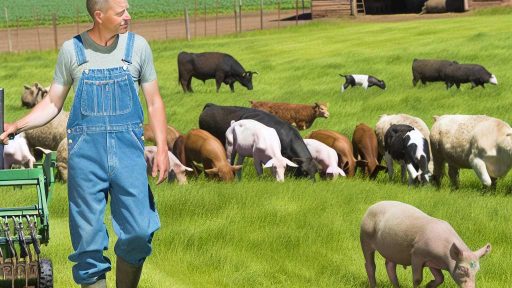Understanding Labor Costs and Expenses in Farming
Importance of Controlling Labor Costs
Labor costs form a significant portion of farming expenses.
By controlling these costs, farmers can improve their profitability.
Moreover, effective management leads to operational efficiency.
Breakdown of Labor Expenses
Labor expenses include wages, benefits, and insurance costs.
Wages depend on the type of work and employee skill level.
Additionally, benefits may include health insurance and retirement plans.
Insurance costs protect both the farmer and the employees.
Factors Affecting Labor Costs
Several factors influence labor costs in farming operations.
Seasonal fluctuations can affect the availability of workers.
Market demand for products can also impact labor needs.
Furthermore, agricultural policies may alter wage rates.
Strategies to Optimize Labor Use
Optimizing labor use starts with careful planning.
Implementing efficient scheduling can minimize wasteful hours.
Additionally, investing in training boosts worker productivity.
Embracing technology can streamline various farming tasks.
Transform Your Agribusiness
Unlock your farm's potential with expert advice tailored to your needs. Get actionable steps that drive real results.
Get StartedAssessing Labor Efficiency
Regularly assessing labor efficiency is crucial for cost control.
Utilizing key performance indicators helps measure productivity.
Gathering data on labor output allows for informed decision-making.
Moreover, identifying bottlenecks can enhance overall efficiency.
Maintaining Employee Satisfaction
Happy employees are often more productive and loyal.
Offering competitive wages and benefits can improve morale.
Additionally, promoting a positive work environment fosters retention.
Conducting regular feedback sessions can address employee concerns.
Implementing Efficient Hiring Practices for Seasonal Workers
Identifying Labor Needs
First, analyze your farm’s seasonal labor needs.
Consider peak times for planting and harvesting.
Make a detailed list of required tasks and skills.
This will help you determine the number of workers needed.
Attracting Qualified Candidates
Create clear and appealing job descriptions.
Highlight the benefits of working on your farm.
Utilize local job boards and community resources.
Outreach can improve your chances of finding qualified candidates.
Streamlining the Application Process
Simplify the application process for potential workers.
Use online forms to manage applications efficiently.
Clearly communicate the timeline for hiring decisions.
This will help candidates feel informed and engaged.
Conducting Effective Interviews
Structure your interviews to assess skill sets directly.
Include practical tasks related to farming operations.
Ask questions about previous experiences in agriculture.
Evaluate candidates based on their problem-solving abilities.
Showcase Your Farming Business
Publish your professional farming services profile on our blog for a one-time fee of $200 and reach a dedicated audience of farmers and agribusiness owners.
Publish Your ProfileTraining and Onboarding
Develop a comprehensive training program for new hires.
Cover safety practices and essential farm procedures.
Encourage mentorship among experienced workers.
This fosters a supportive work environment.
Retention Strategies
Implement retention strategies to keep seasonal workers.
Offer competitive wages and timely payments.
Provide incentives for good performance and length of service.
Regular feedback can enhance job satisfaction.
Training and Development: Building Skills for Productivity
Importance of Training in Agriculture
Training improves the skills of farm workers significantly.
It enhances overall productivity and efficiency on the farm.
Additionally, well-trained employees can adapt to new technologies quickly.
Moreover, training reduces the likelihood of accidents and injuries.
Types of Training Programs
Various training programs cater to specific farming needs.
One effective program is hands-on training in crop management techniques.
Another valuable program focuses on the operation of machinery safely.
Additionally, management training helps supervisors lead their teams effectively.
Developing Training Materials
Creating effective training materials is essential for successful programs.
Use clear and straightforward language that everyone can understand.
Visual aids such as charts and videos can enhance learning.
Interactive sessions promote engagement and retention of information.
Evaluating Training Programs
Evaluating training programs is crucial to measure their effectiveness.
Collect feedback from participants to identify areas for improvement.
Implement assessments to gauge knowledge retention and application.
Regularly review and update training materials based on new practices.
Continuous Development Opportunities
Encourage ongoing learning beyond initial training.
Workshops and seminars can introduce the latest industry innovations.
Online courses provide flexibility for employees seeking further education.
Additionally, mentorship programs can foster individual growth and development.
Collaboration with Educational Institutions
Partnering with local colleges can enhance training efforts.
These institutions often provide resources and expertise in agriculture.
Collaboration can lead to specialized courses tailored for your farm.
Moreover, internships offer practical experience for students entering the field.
Discover More: Organic Fertilizer Use To Decrease Production Costs
Utilizing Technology for Labor Management and Efficiency
Adopting Farm Management Software
Farm management software streamlines farm operations efficiently.
Farmers can track labor hours, crop progress, and equipment usage.
This data aids in making informed decisions about resources.
Moreover, software helps identify areas for improvement.
Implementing Robotics and Automation
Robotics enhance productivity and reduce labor costs dramatically.
Automated systems handle repetitive tasks like planting and harvesting.
As a result, farms can operate with fewer workers.
Showcase Your Farming Business
Publish your professional farming services profile on our blog for a one-time fee of $200 and reach a dedicated audience of farmers and agribusiness owners.
Publish Your ProfileAdditionally, automation minimizes human error in these processes.
Leveraging Mobile Applications
Mobile applications provide real-time data access for farm managers.
Farmers can communicate with workers regarding job assignments.
This flexibility enhances coordination among team members.
Furthermore, mobile apps offer insights into market trends.
Utilizing GPS and Drones in Farming
GPS technology and drones improve field mapping and crop monitoring.
This technology allows for precise planting and irrigation.
Drones can quickly survey large fields for pest control needs.
This capability saves time and reduces resource wastage.
Training Workers on Technology
Training staff to use technology is vital for optimal operation.
Structured training programs enhance worker efficiency and productivity.
Furthermore, educated workers adapt better to new technologies.
A skilled workforce leverages technology to achieve better outcomes.
Learn More: Crop Rotation Techniques for Sustainable Diversification
Creating Flexible Work Hours to Enhance Employee Satisfaction
Importance of Flexible Work Hours
Flexible work hours significantly boost employee morale.
They allow workers to balance personal and professional commitments.
In the farming sector, this flexibility is crucial, especially during peak seasons.
Boosting Productivity Through Flexibility
Offering flexible hours can lead to increased productivity.
Employees can work when they feel most energetic.
This flexibility can enhance focus and reduce exhaustion.
Ultimately, it benefits the farm’s overall output.
Strategies to Implement Flexible Hours
Start by assessing workers’ preferred schedules.
Survey employees to identify their ideal work hours.
Consider implementing a shift system that accommodates different needs.
Encourage team discussions to establish common hours.
Regularly review and adapt the schedule based on feedback.
Case Studies of Successful Implementation
Green Acres Farm offers employees tailored shifts based on their availability.
This approach has led to higher job satisfaction rates.
Additionally, Sunny Fields Cooperative noticed improved employee retention after shifting to flexible hours.
These case studies exemplify the benefits of adaptability in work schedules.
Challenges and Considerations
While flexibility is beneficial, it comes with challenges.
Maintaining effective communication can become more complicated.
Ensure all team members are aware of each other’s schedules.
Lastly, implement monitoring systems to track productivity fairly.
See Related Content: Financial Analysis Tools Every Farmer Should Utilize For Success

Effective Communication Strategies for a Cohesive Workforce
Establishing Clear Goals
Clear goals improve overall team focus.
First, ensure each worker understands their role.
Next, communicate farm objectives regularly.
Use visual aids to depict key goals.
Additionally, review these goals in regular meetings.
Showcase Your Farming Business
Publish your professional farming services profile on our blog for a one-time fee of $200 and reach a dedicated audience of farmers and agribusiness owners.
Publish Your ProfileUtilizing Technology for Communication
Leverage technology to facilitate dialogue.
For instance, use messaging apps for quick updates.
Video calls can enhance remote team spirit.
Furthermore, adopt project management tools for task tracking.
Such tools foster transparency across the workforce.
Encouraging Open Dialogue
Open dialogue builds trust among team members.
Encourage questions during team gatherings.
Implement suggestion boxes for anonymous feedback.
Additionally, promote a culture of constructive criticism.
This practice encourages ongoing improvement.
Conducting Regular Training Sessions
Training sessions strengthen workforce skills.
Schedule workshops on communication techniques.
Include role-playing exercises to practice scenarios.
Moreover, invite guest speakers for fresh perspectives.
Such sessions enhance cohesion and morale.
Fostering Team Bonding Activities
Team bonding activities promote strong relationships.
Organize group outings to cultivate camaraderie.
Consider team-building exercises that align with farming tasks.
Additionally, encourage social events after work hours.
These initiatives lead to a more unified workforce.
Find Out More: Pricing Models To Maximize Revenue In Agritourism Offerings
Performance Monitoring
Importance of Metrics
Metrics play a crucial role in evaluating staff efficiency.
They provide insights into labor productivity on the farm.
Using metrics helps identify areas for improvement.
Moreover, it enhances development and growth among team members.
Selecting Key Performance Indicators
Selecting the right key performance indicators (KPIs) is essential.
Common KPIs include labor hours, crop yields, and task completion rates.
Establishing benchmarks for these metrics can guide performance evaluation.
Furthermore, it allows for comparison against industry standards.
Implementing a Monitoring System
Implementing a structured monitoring system ensures consistency.
This system should track metrics regularly for accurate data collection.
Digital tools and software can simplify monitoring processes.
In addition, they facilitate easy access to performance data.
Providing Feedback and Support
Regular feedback is vital for improving staff performance.
It encourages open communication between management and employees.
Additionally, providing support helps staff understand their strengths.
It also identifies areas needing further development.
Reviewing and Adjusting Strategies
Periodic reviews of labor management strategies are necessary.
Adjusting strategies based on performance data enhances efficiency.
Incorporating staff input during reviews fosters a collaborative environment.
Showcase Your Farming Business
Publish your professional farming services profile on our blog for a one-time fee of $200 and reach a dedicated audience of farmers and agribusiness owners.
Publish Your ProfileThis approach leads to innovative solutions for productivity challenges.
Incentive Programs: Motivating Workers for Maximal Output
Understanding the Importance of Incentives
Incentive programs enhance productivity in agricultural settings.
They motivate workers to achieve higher output levels.
Moreover, effective incentives foster employee retention.
Types of Incentive Programs
Financial incentives are a popular choice for many farms.
Performance bonuses reward individuals for surpassing set goals.
Profit sharing aligns workers’ goals with the farm’s success.
Other options include salary increases based on performance.
Non-monetary incentives can also be impactful.
Recognition programs celebrate individual and team achievements.
Providing professional development opportunities encourages skill enhancement.
Designing an Effective Incentive Program
Clarity is vital when crafting an incentive program.
Clearly defined goals help employees understand expectations.
In addition, fair benchmarks ensure everyone can participate.
Regular reviews maintain program effectiveness.
Gather feedback from workers to improve the system continually.
Furthermore, transparency fosters trust between management and staff.
Implementing Incentive Programs
Start by communicating the program to all employees.
Training sessions can facilitate understanding and buy-in.
Display success stories to inspire and motivate the team.
Tracking progress regularly keeps momentum going.
Additionally, celebrate milestones to create a positive atmosphere.
Evaluating the Effectiveness of Incentive Programs
Regular assessments are essential for measuring results.
Track productivity metrics before and after implementation.
Conduct employee surveys to gauge satisfaction levels.
Adjust programs based on outcomes and feedback.
Ultimately, a responsive approach maximizes the benefits of incentives.
Additional Resources
USDA Strategic Plan FY 2018 – 2022
U.S. Fruit and Vegetable Industries Try To Cope With Rising Labor …




